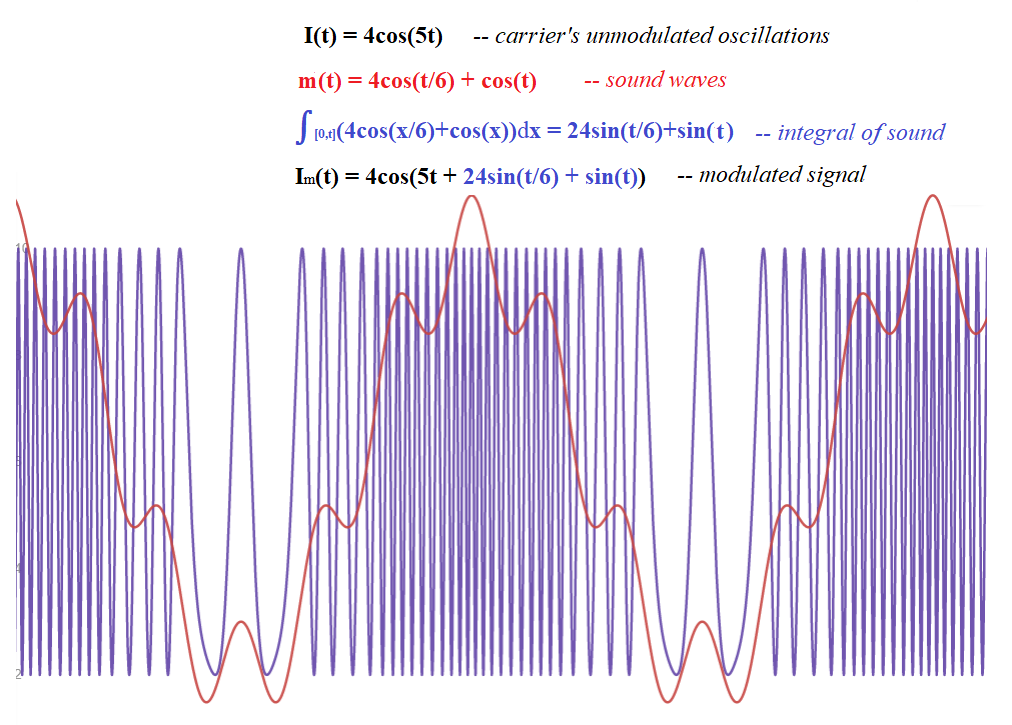FM Equation
Our plan is to come up with a mathematical representation of a frequency modulated oscillations of carrier waves that incorporate given sound waves.
Sound waves are changes in the air pressure and can be represented by some function of time m(t) (m stands for modulation, as we want this signal to modulate the frequency of sinusoidal carrier signal).
Practically, m(t) is the changes in the current of some circuit that contains a microphone, that converts the air pressure changes into synchronous changes in the electric current.
Let's discuss the concept of angular frequency of the carrier signal in more mathematical terms.
Frequency f, if constant, is the number of periods of oscillations per unit of time (second).
It's often expressed in radians per second ω=2πf and unmodulated oscillations of an electric current in the carrier LC circuit that produces base oscillations would be
I(t) = A·cos(ω·t)
This sinusoidal function of time I(t) that represents oscillations of electric current can be viewed as an X-coordinate of a point on a circle of radius A (amplitude of oscillations) with a center at the origin of coordinates, that rotates along a circle counterclockwise with constant angular speed ω radians per second, assuming that at t=0 it is located on the X-axis at point (A,0).
So, angular frequency in more mechanical terms is angular speed.
From now on we will consider the above presented rotation of a point as mathematical representation of sinusoidal oscillations.
Another important characteristic of an oscillation is its phase φ(t).
The definition of a phase is an angle a rotating point has rotated to during the time of rotation from its start up to a current moment t, which can be expressed as a time-dependent function φ(t).
From this definition immediately follows the analogy between kinematics terms distance, speed and concepts phase, angular frequency used in radio electronics.
This analogy is complete in a sense that the relationship between a phase φ(t) and angular frequency ω(t) is similar to that between a distance S(t) covered by a moving object and its instantaneous speed V(t).
The instantaneous speed at moment in time t in, generally, a non-uniform movement, as a function of time, is a derivative of a distance covered by a moving object from the start of movement up to a position at time t, as a function of time:
V(t) = dS/dt = S'(t)
Similarly, angular frequency (sometimes called instantaneous angular frequency or simply instantaneous frequency) is the first derivative of a phase (angle of rotation) as a function of time:
ω(t) = dφ/dt = φ'(t)
Knowing speed V(t) of a moving object at every moment of time from start to t, we can restore the distance S(t) covered by this object as a function of time
S(t) = ∫[0,t]V(τ)·dτ
Similarly, we can restore the phase φ(t) (that is, an angle a point has rotated from the start of its rotation to a moment in time t), knowing the instantaneous angular frequency ω(t) at each moment of time.
φ(t) = ∫[0,t]ω(τ)·dτ
Consider the main equation of oscillations of an electric current in the LC circuit of a carrier without any sound modulation
I(t) = A·cos(ω0·t)
The argument to a function cos() is a product of a constant angular frequency (speed) ω0 by time, which is an angular distance of rotation or, using terminology introduced above, a phase of the rotation at time t
φ(t) = ω0·t
Therefore, our representation of carrier signal can be expressed in a more general form, suitable even for non-uniform rotation:
I(t) = A·cos(φ(t))
In a non-uniform rotation with variable instantaneous angular frequency ω(t) we can always derive this frequency from the phase:
ω(t) = φ'(t)
If we want to combine the carrier signal I(t) with some frequency modulating signal m(t) in such a way that the resulting variable instantaneous frequency ωmod(t) of a modulated signal reflected the modulation, we need to satisfy the following equation:
ωmod(t) = ω0 + m(t)
where
ω0 is the carrier own unmodulated constant frequency determined by it main LC circuit,
m(t) is a modulating add-on to reflect the sound waves to be transmitted.
We can even vary the degree by which the modulating affects the output signal by adding a modulating index λ as a factor to a modulator m(t):
ωmod(t) = ω0 + λ·m(t)
Knowing the target instantaneous frequency ωmod(t) and the above expression of a phase in terms of this frequency
φ(t) = ∫[0,t]ω(τ)·dτ
we can express the modulated phase as
φmod(t) = ∫[0,t]ωmod(τ)·dτ
This modulated phase will be an argument to a modulated signal of a carrier
Imod(t) = A·cos[φmod(t)] =
= A·cos[∫[0,t]ωmod(τ)·dτ] =
= A·cos[∫[0,t](ω0+λ·m(τ))·dτ] =
= A·cos[ω0·t+λ·∫[0,t]m(τ)·dτ]
The role of modulation index λ in this formula is to define how significantly base carrier frequency should change with a change in sound waves frequency.
Below is a picture of a rather complicated air pressure oscillations (red) and the resulting modulated signal (purple) that represents the carrier frequency modulation by this sound together with equations that represent all the components of this frequency modulation

(you can click the right mouse button and open this picture in another tab for better view)


No comments:
Post a Comment